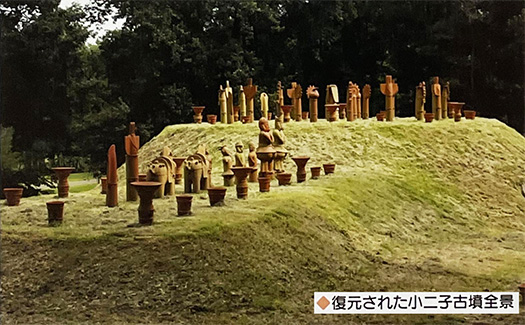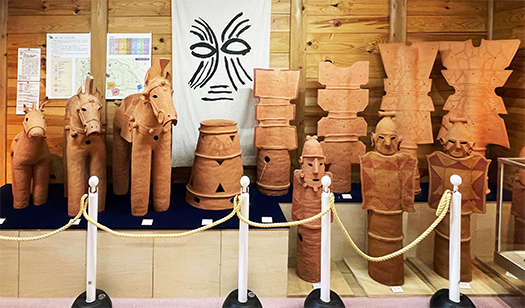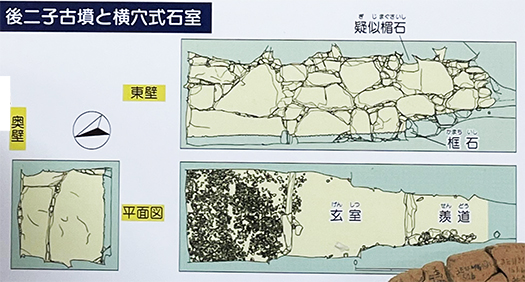


古墳という文化はある時期の日本文化を表現している。
仏教の導入、その興隆と前後して古墳文化は消えていくから
その文化性の大きな部分は仏教寺院に置換したとわたし的には思う。
ヤマト王権はその勢力拡大局面では古墳文化をアイコンとして
各地域での覇権を確立させていったと思える。
上の写真は大室古墳群のなかの「小二子古墳」の復元想定。
本来はこの前方後円墳全体に白い葺き石が覆われていたとされるけれど、
いかにも建築的な意図を感じさせると思う。
巨大な土木建築技術のアイコンでもあったといえる。
仁徳陵・大仙古墳は当時の海岸線からの眺望を意識したといわれる。
瀬戸内海を航海してきた外交使節などに対して
この島嶼国家王権の存在を強く印象づける意図を持っていたとされる。
やがて有用な葺き石が徐々に剥ぎ取られていって
前方後円の形状のままに自然に還元されていったのだろう。
こういう形状の建築性の高い景観のなかで王権の象徴的儀式が
ここで行われることで、権威性・支配根拠の刷り込みが行われた。
まことに、文字による記録性が存在流通しない時代には
政治経済軍事の総体的支配をあきらかにする営為だったのだと思う。
王権を行使していた人物が死亡したとき、
のちの世での「殉死」にも似た行為代償として埴輪が役立てられた。
石で組み上げられる「玄室」空間にも在りし日の遺品が収容され
その時代の空気感を伝えるタイムカプセルの役割を果たしている。
弥生時代以来の創造物として日本独自の埴輪文化をわたしたちは持つ。
ウマなどの表現には、その後の日本の芸術文化のルーツを感じる。
大和絵などから現代のマンガ文化にまで至る抽象力が凝縮されている。
日本人はこのように感じるという認識力文化。
古墳にしろ、埴輪にしろ、そういった価値感にはどのような
再現文化性が意図されていたのか、興味深い。
たぶんそこでの制作時に意図されたものがヤマト王権文化そのもの。
もちろん制作者や制作工房はその古墳とほど近い場所にあった。
普通に考えると王権側お抱えの専門家集団の存在が想像できる。
後の世の「狩野派」のような専門家集団が関与していたことはあきらか。
縄文の世が残した岡本太郎的な情念的ワイルドさは息を潜め、
形態的には科学性重視の理科系的な表現感覚が印象づけられる。
列島社会で優勢になっていったヤマト王権としては、
このような感覚常識を普遍性デザイン感覚と認識推奨していたのか。
農業土木技術による田んぼの造作、導水技術からの自然な展開として
理科的単純さ・幾何形体重視が優先されたのだろうか。
今日のわたしたちの感覚世界に於いても、生きたテーマとして
こういった造形意図の感覚は奥深くに根付いている。
言ってみれば建築空間創造のパトス部分の文化性とも感じる。
English version⬇
Kofun and Haniwa are the expression of sensitivity before writing.
When I look at Haniwa, I am not attracted by its cartoonishness (laugh). It is interesting to know that people in the past also saw things in this way. …
The culture of kofun tumuli represents a particular period of Japanese culture.
In my opinion, a large part of that culture was replaced by Buddhist temples.
The Kofun culture disappeared around the time of the introduction of Buddhism and its rise.
The Yamato regime used the Kofun culture as an icon during the expansion of its power.
The above photo shows the Oomuro tumulus group.
The photo above is a reconstruction of the Kojiko burial mound in the Omuro burial mound complex.
It is said that the entire tomb was originally covered with white thatched stones.
I think it was intended to be architectural in nature.
It was also an icon of massive civil engineering and construction technology.
The Nintoku-ryo and Daisen-kofun tumuli are said to have been built with an awareness of the view from the coastline at that time.
To diplomatic envoys and others who sailed through the Seto Inland Sea
It is said that the intention was to strongly impress the presence of the royalty of this island nation upon diplomatic envoys and others who sailed across the Inland Sea.
Eventually, the useful thatched stones were gradually stripped away
The thatched stones were gradually stripped away and left in their natural shape of an antero-posterior circle.
The symbolic rituals of kingship in this highly architectural landscape of this shape
The symbolic rituals of kingship were performed here in this highly architectural landscape, thus imprinting a basis of authority and dominance.
In fact, in an age when written records did not exist and circulate
I believe that this was an activity to clarify the overall control of politics, economy, and military affairs at a time when written records did not exist and circulate.
When a person who exercised royal authority died, he or she was
When a person who exercised royal power died, haniwa (clay figurines) were used as compensation for the act, which was similar to “martyrdom” in later times.
The “Genkan” space, constructed of stone, also houses relics from the past.
The “bas-reliefs” are also placed in the “bas-relief space,” which is made of stone and serves as a time capsule to convey the atmosphere of that period.
Haniwa culture is unique to Japan as a creation since the Yayoi period.
The expression of “Uma” (horse) is the root of the Japanese art culture that followed.
The power of abstraction, from Yamato-e to the modern manga culture, is condensed in these expressions.
Japanese people have the power of perception and culture to feel this way.
Whether it is a burial mound or a haniwa, what kind of value is intended in such a sense of value?
It is interesting to know what kind of reproduction culture was intended for such a sense of value.
Perhaps what was intended at the time of production there is the Yamato Royalty culture itself.
Of course, the creator and his workshop were located in close proximity to the tomb.
It is possible to imagine the existence of a group of specialists who were retained by the royal authority.
It is clear that a group of experts like the “Kano school” of later generations was involved.
The Taro Okamoto-like emotional wildness left behind by the Jomon period has been replaced by a more scientific and scientific approach in terms of form.
The morphology of the work gives the impression of a science-oriented, science-oriented sense of expression.
As the Yamato kingdom became dominant in the archipelagic society
The Yamato kingdom, which prevailed in the archipelago, recognized and recommended this kind of sensory common sense as a sense of universal design.
The natural progression from the construction of rice paddies and water conduit technology as agricultural engineering technology is the use of scientific simplicity and geometric shapes.
Did the emphasis on scientific simplicity and geometric forms take precedence?
In today’s world of our senses, this kind of sense of formative intent is still a living theme.
This sense of intentionality is deeply rooted in our sensory world today.
In other words, I feel that it is a cultural aspect of the pathos of architectural space creation.
Posted on 8月 14th, 2022 by 三木 奎吾
Filed under: 住宅マーケティング, 日本社会・文化研究







コメントを投稿
「※誹謗中傷や、悪意のある書き込み、営利目的などのコメントを防ぐために、投稿された全てのコメントは一時的に保留されますのでご了承ください。」
You must be logged in to post a comment.